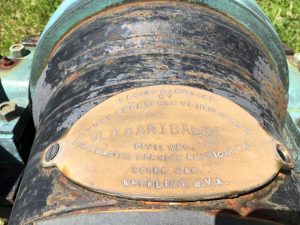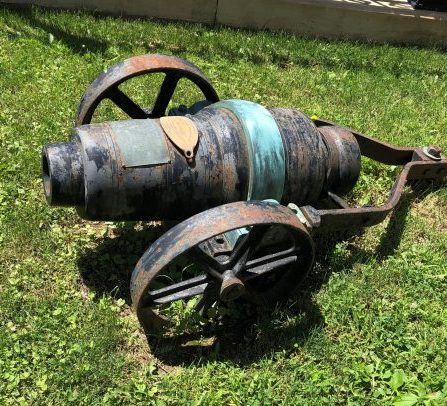Artillery: Old Garibaldi – A Most Unusual Cannon
 Emerging Civil War welcomes back guest author Jon-Erik Gilot
Emerging Civil War welcomes back guest author Jon-Erik Gilot
 One of the more visible reminders of the Civil War – even for those of us far removed from the battlefields – are the cannons dotting our city parks, cemeteries, and courthouse lawns. As technology advanced in the decades after the war, the cannons were decommissioned and made available to veterans groups, battlefield parks, and municipalities, their purpose changing from deadly to decorative.
One of the more visible reminders of the Civil War – even for those of us far removed from the battlefields – are the cannons dotting our city parks, cemeteries, and courthouse lawns. As technology advanced in the decades after the war, the cannons were decommissioned and made available to veterans groups, battlefield parks, and municipalities, their purpose changing from deadly to decorative.
While some were sacrificed during World War II scrap metal drives, my area of the Upper Ohio Valley still retains some terrific examples of 19th century artillery pieces. Walnut Grove Cemetery in Martins Ferry, Ohio, is home to a Confederate 12-pound Napoleon cast at the Augusta Foundry in 1864. Weeks Cemetery in Bridgeport, Ohio contains a Mexican War era cannon that was hauled out of retirement by local militia during Confederate General John Hunt Morgan’s Raid in July 1863. Perhaps the most unusual of our local artillery pieces sits in the yard of West Virginia Independence Hall in downtown Wheeling, West Virginia.
It’s a short, pudgy little thing, looking more like a toy cannon to be fired at the start of a 5K race. The wheels and carriage look as though they were fashioned from scrap machinery. Interestingly enough, that may be just the case. The cannon, dubbed “Old Garibaldi,” – a nod to the great 19th century Italian general Giuseppe Garibaldi – was cast at the LaBelle Iron Works in Wheeling, Virginia. LaBelle is not remembered by Civil War historians for pumping out artillery like the great wartime foundries at Allegheny, Tredegar, or Augusta…because it didn’t.
LaBelle Iron Works was founded in Wheeling in 1852 to produce cut nails. Located in the multiethnic community of South Wheeling, the plant employed German and Irish immigrants to operate more than 60 cut nail machines capable of producing upwards of a million nails per annum. By the early 1870’s, LaBelle alone produced a quarter of all nail production in the United States. Wheeling is today remembered as “Nail City,” with our popular ECHL Hockey team named “The Nailers.”
While local lore holds that Old Garibaldi was cast at LaBelle in 1861, a quick scan of the local newspapers reveals that the cannon – weighing a half ton – was already in use by 1860. The Daily Intelligencer reported on November 09, 1860 that the “Labelle Mill boys fired from the side of Chapline Hill 36 guns – 33 for the States, one for Kansas, one for the Union, one for Richietown [South Wheeling], and all for the glorious victory which places Lincoln in the Presidential chair. The cannon used was ‘Old Garibaldi,’ which the Labelle boys made themselves.” [i] The cannon was also loaned to local Republican groups who would parade the cannon around town into the 1880’s.
LaBelle lost a significant part of their workforce in the spring of 1861 as many of the workers enlisted in the 1st Virginia Infantry then forming in Wheeling. The men formed the nucleus of Company B, dubbed the “Iron Guards.” Following the battle at Philippi, Virginia on June 3, 1861, the Iron Guards sent a Confederate flag captured in battle back to Wheeling. The flag was presented to “the Union ladies of LaBelle” – the mothers, wives and sweethearts of the LaBelle workers.[ii]
 Old Garibaldi was destined to stay at LaBelle while the Iron Guards served during the war. In April 1865, the townsfolk wheeled the cannon out and fired to mark the end of the war, starting something of a tradition for Old Garibaldi and the nail workers. Ranging from the Spanish-American War to the Persian Gulf War, Old Garibaldi was wheeled out and fired to mark the end of hostilities for each American conflict. In 1991, the workers at LaBelle affixed a plaque to Old Garibaldi listing each conflict after which the cannon was fired, with a final, fitting tribute that “We pray to God that this cannon is never fired again.” While we have found ourselves in conflict since the plaque was placed, the cannon has indeed remained silent.
Old Garibaldi was destined to stay at LaBelle while the Iron Guards served during the war. In April 1865, the townsfolk wheeled the cannon out and fired to mark the end of the war, starting something of a tradition for Old Garibaldi and the nail workers. Ranging from the Spanish-American War to the Persian Gulf War, Old Garibaldi was wheeled out and fired to mark the end of hostilities for each American conflict. In 1991, the workers at LaBelle affixed a plaque to Old Garibaldi listing each conflict after which the cannon was fired, with a final, fitting tribute that “We pray to God that this cannon is never fired again.” While we have found ourselves in conflict since the plaque was placed, the cannon has indeed remained silent.
 When LaBelle fired the cannon for a final time in 1991, perhaps they didn’t give the local community enough notice. Traffic was disrupted on the interstate which ran behind the nail plant. Concerned neighbors contacted the authorities. In the end, the city suggested that the cannon should be retired. The workers spiked the gun and mounted it in a corner of the plant property. Old Garibaldi holds the distinction of having never been fired in anger.
When LaBelle fired the cannon for a final time in 1991, perhaps they didn’t give the local community enough notice. Traffic was disrupted on the interstate which ran behind the nail plant. Concerned neighbors contacted the authorities. In the end, the city suggested that the cannon should be retired. The workers spiked the gun and mounted it in a corner of the plant property. Old Garibaldi holds the distinction of having never been fired in anger.
LaBelle closed in 2010 after 158 years of producing high quality cut nails. In 2015, the contents of the plant – including the original 1850’s nail machines that were still in use at the time the plant closed – were put up for auction. Then Old Garibaldi was rediscovered. The new owner of the property agreed that rather than auction the historic artifact, the cannon would be deeded to the state and transferred to nearby West Virginia Independence Hall where it continues to stand guard today.

(archivingwheeling.org)
In 2017, the sprawling LaBelle plant was torn down to make way for a new housing development. As such, Old Garibaldi now stands as one of the only visible reminders of LaBelle’s rich history in Wheeling. With the pending relocation of Wheeling’s Soldiers & Sailors Monument – the largest and second oldest in the state – to the courtyard at West Virginia Independence Hall, plans are in place to refurbish the cannon and place it on an appropriate foundation.
Jon-Erik M. Gilot holds degrees from Bethany College and Kent State University. He has been involved in the fields of archives and preservation for more than a decade and today works as an archivist in Wheeling, West Virginia.
Sources:
[i] Daily intelligencer. (Wheeling, Va. [W. Va.]), 09 Nov. 1860. Chronicling America: Historic American Newspapers. Lib. of Congress.
[ii] Daily intelligencer. (Wheeling, Va. [W. Va.]), 07 June 1861.

2 Responses to Artillery: Old Garibaldi – A Most Unusual Cannon